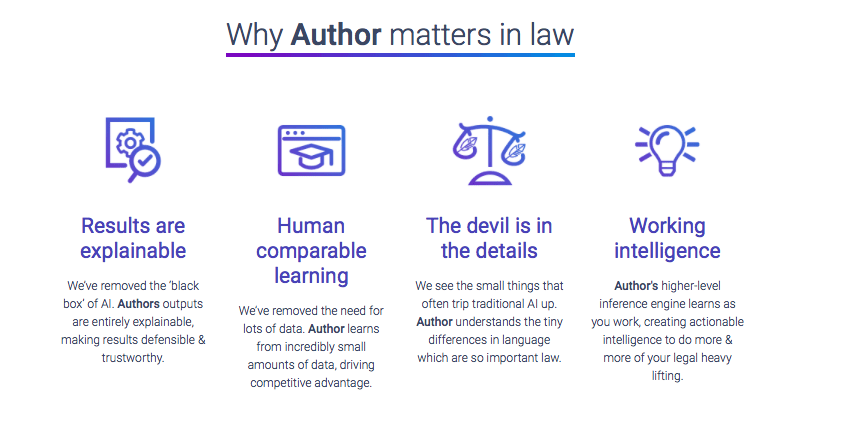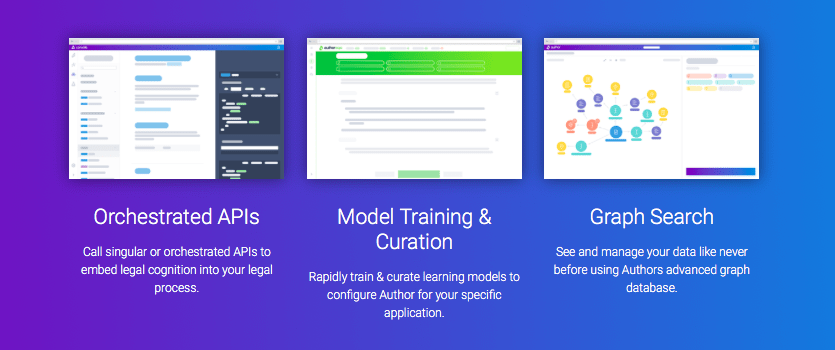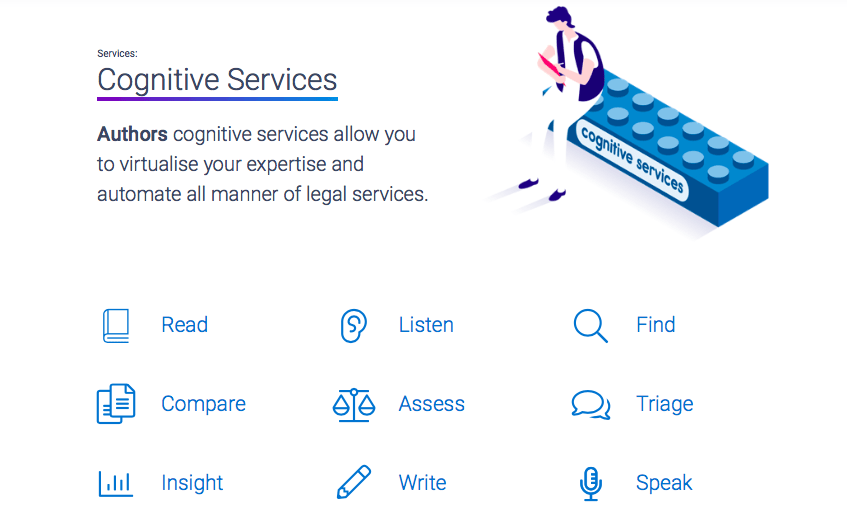
Meet Author, the new legal AI system that is set to take on the world, created by a group in New Zealand called McCarthyFinch. To find out some more Artificial Lawyer interviewed founder and CEO, Nick Whitehouse, (see below).
But first, what is Author?
Last week, amid a flurry of other AI news a company few had heard of before from New Zealand, part owned by the local legal practice MinterEllisonRuddWatts and boutique VC fund Goat Ventures, announced it was taking part in a pitch battle at a TechCrunch event.
In their announcement the company says its legal AI platform can learn ‘100 times’ faster than other legal AI systems with less data needed. It’s also launched after being trained for around half a dozen different use cases, not just M&A doc review.
But, where had all of this suddenly come from?
Artificial Lawyer covered the launch of the joint venture’s creation back in March 2017 and the leaders of the project have been good to their word and delivered a very comprehensive AI platform.
So, here is Artificial Lawyer’s interview with Whitehouse to explain all of the above and to hopefully shed some light on the major claims the company is making.
First, can you tell the readers some of the background to the creation of Author?

We started out as a joint investment between MinterEllisonRuddWatts and the Boutique AI VC Goat Ventures. I was the Chief Digital Officer at Minters and was leading innovation in the firm (both sustaining and disruptive).
After interaction with many AI products in the market, we realised pretty quickly that nothing really existed to help us create radical competitive advantage through technology.
If the firm used products such as Luminance and Kira Systems for example, they’d derive the same benefits from the firm down the road, and broad solutions such as IBM Watson or Azure were incredibly intensive (and expensive) to train, gain accuracy, integrate and build upon.
Of course, underlying all of this there was and is a clear need to innovate. 41% of in-house legal teams are looking to redirect legal spend into technology, 60+% of law firms are trying innovate with many of them struggling to extract benefits from such investments.
Pressure on the billable hour continues to strain the demand for legal services, over the last 5-6 years there have been large declines in the demand for billable hours for senior lawyers, while junior hours have remained relatively stable, this is largely masked by rising rates.
However, empirically, there is a growing disaggregation in the value of legal services, and as a consequence the accelerating commoditization of legal services – which is not good for the industry. The easy answer has been innovation with point-solution products.
Firms can quickly save time and reduce cost, getting immediate reinforcement by clients, but the kicker here is that this only serves to commoditize the market even faster. So philosophically, we believed we needed to do something different and offer the legal industry new ways to create value when transferring their legal expertise. Ultimately, it’s not the time it takes a lawyer to transfer their expertise, but rather the quality of their expertise that creates value.
This is the purpose of Author, a platform for the industry to rapidly virtualise and weaponise their competitive expertise through artificial intelligence and truly gain market share.
We call this arming the armies, from “enlightened law firms”, in-house teams, and even legaltech providers who on initial glance you’d think were competitors. Our goal is to improve the access to and practice of law, and we see our role as supporting everyone who wants to do so.
You’ve said that Author can ‘learn 100 times faster than traditional AI systems’. In what way is it faster? What makes it so different?
Author is different for a number of reasons. We’ve spent nearly 18 months, head down with a diverse and award winning group of AI PhDs, Data Scientists, Legal Engineers and Lawyers mapping the cognitive processes that Lawyers go through when acting for clients.
It was obvious to us within a matter of weeks that taking a single AI approach such as Deep Learning was not going to create true value, while it’s a great tool, it is just one tool in our toolbox so to speak.
This lead us to build a number of new patent pending AI techniques that focus on small dataset learning, nuance and explainability.
The techniques, in combination with more traditional AI approaches allow us to learn in different ways, much quicker. For example, we were challenged to classify court decisions, the team we were working with did so with 11,000 training examples, manually tagged, which took a fairly long time. They achieved ~91% accuracy.
It took us 90 mins to achieve ~93% accuracy from roughly 160 examples of court decisions.
When it comes to contracts, we’ve been able to train and learn clauses with high accuracy from as little as 2 – 4 examples, in-line as lawyers work. In practice this has radically changed AI as a proposition in law, because it gives lawyers the ability to train bespoke points of intelligence in broad range of areas in-line and differentiate their outputs competitively.
When you say it ‘interprets the meaning behind the words’, how is this different from other legal AI NLP systems?
NLP has been around for a long time, particularly text-mining and translation, in-fact it really did kick off the Machine Learning revolution before we saw a big shift towards computer vision.
What we found however was that for a Lawyer to trust and really gain value out of an AI, it needs to be explainable and able to pick up on nuance. In practice that means enriching information that is found on a page, connecting all the information in a document, i.e. not simply identifying a party, but understanding what side of the contract that party sits.
Understanding whether a term is defined or not, whether a cross-referenced clause is referenced correctly, what other documents are associated with a contract and does this conflict, how favourable clauses, provisions and terms are etc. This is the implicit legal reasoning a lawyer does when reading, and this is what was important to us when creating custom, domain specific ‘cognitive services’.
You’ve taken the approach of training the system for multiple use cases, rather than just one or two. Why this strategy?
We don’t believe in commoditising law. We set out to virtualise legal cognition to augment existing legal processes to create value.
To do this effectively we’ve purposely worked across many areas of law, from community law, courtrooms, in-house, traditional law firms and legaltech providers, both testing our technology and gathering insight on where real deficiencies exist, and what cognitive services would deliver the greatest benefit to the most people. This has put us and our technology in a great position. We see four generalised areas that cut right across the industry.
Review, Draft, Insight and Triage, and these are the areas we have built out our cognitive services.
Also, can we presume this will be aimed at other law firms, and will MinterEllison be using this?
At the moment I can’t comment on whether someone is a client or not, what I will say is that we are working with ten different clients, ranging from global professional services businesses, traditional firms, government agencies and global enterprises, across Australasia, Europe and the United States.
[But] Yes, Minters is testing and using the system, they are comfortable with other firms, though have a level of exclusivity in NZ.
Thanks! Exciting to see a new legal AI company and platform coming to the world stage.
P.S. Last word from Whitehouse is that the company is now looking for additional external funding….so, now you know…
P.P.S. Below is a list of some of the use cases Author has already been trained up for. While most legal AI companies launch with one main use case, e.g. lease extraction, they’ve gone the other way and sought to apply it from day one to just about everything they can. Here’s some examples:
- Settlement Insight:Helps legal teams negotiate the best settlement for their clients or companies by extracting settlement values from 35,000 agreements across the U.S. It then groups these values by court, state and other parameters to create comparable databases.
- Contract Favorability Review: Breaks down a contract into different clauses and sections, analyzing each part and identifying whether it’s in a client’s favor or not. It also identifies missing or added clauses and text to speed up everyday document review.
- M&A Insight:Reads through public and private mergers and acquisitions to create an insight report for advising clients, negotiating transactions and attracting new clients. At one firm, this reduced junior legal effort by 99 percent.
- Court Decision Classification:The AI platform was put to the test classifying court decisions against a team of legaltech workers. While it took the human team six weeks and an undisclosed cost to classify five decisions with 91 percent accuracy, it took the AI platform only two hours and no cost to classify eight decisions with 94 percent accuracy.
- Tax Determination:Revolutionizes legal research for government tax decisions, turning a multi-week process into one that only takes minutes. Author does this by taking latent information from physical documents and turning it into a research interface.
- Transactional Contract Automation:Author automatically approves contracts when they conform to existing laws and company policies, providing review tools and insights for the in-house teams only when the contract needs a second look. This reduces in-house legal workload, ultimately allowing revenue to be brought in faster.
- Legal Triage:Author determines the value of clients by acting as a web interface for public legal questions. In an experiment where Author fielded questions before passing them along to lawyers, time spent to resolve these questions reduced by 43 percent. The firm helped twice as many clients for the same cost and effort while resolving low-value questions with little interaction.
- Financial Advice Compliance:Author highlights where inappropriate or incomplete financial advice has been given by comparing the goals of a client with the financial products they’ve been sold.



3 Trackbacks / Pingbacks
Comments are closed.